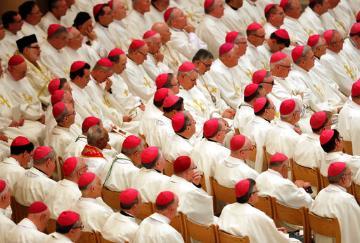
Julie H. Rubio is professor of social ethics at the Jesuit School of Theology of Santa Clara University. Views are her own.
To read the report of the Pennsylvania Grand Jury is to come face to face with the worst that human beings are capable of: willingness to harm the most vulnerable to satisfy one’s own desires; abuse of trust; glorification of power over others; devotion to institution that blinds sensitivity to suffering.
Many are calling the perpetrators—and their many enablers—monsters. As a mother of three sons and a Catholic, I feel the same impulse.
But because I am a theologian who studies sex, gender, and social ethics, I cannot stop thinking about the reality that the actions of perpetrators and enablers were systematic, pervasive, and all too ordinary. Just as the #MeToo movement exposed sexual violence as a pervasive cultural phenomenon, so too, this #ChurchToo moment should inspire a similar willingness to examine not just how perpetrators are brought to justice, but the systemic, cultural problems that made abuse distressingly common.
According to clinical psychologist Mary Gail Frawley-O’Dea, neither pathology nor celibacy nor homosexuality can be blamed for clerical sexual abuse. While some abusers were confirmed pedophiles or ephebophiles, not a small number were “generalists” who chose victims based on opportunity.
Clergy who engaged in abuse shared a “lack of exposure to psychoeducation about emotions and sexuality” which left them “ill-prepared … to function maturely in their vocational careers” and a lack of oversight. Even though abuse is far less common today, denial about deficiencies in the formation of priests continues.
Though the vast majority of priests are not abusers, the accumulating evidence is beginning to suggest that higher estimates (6-9 percent) may be more plausible than lower estimates (4 percent). If one adds to that number the percentage of priests and bishops who knew about, covered up, enabled, or turned a blind eye to abuse, the numbers become significant and deeply troubling.
As the #MeToo movement broadened to include not just stories of “obvious” violation but the far more common stories of bad sex and the cultural assumptions that allow both to thrive, it has taken us deeper into the problem of sexual violence.
Catholics struggling with profound sense of betrayal need to know that their church stands ready to go deeper by interrogating the culture that made abuse and violation both monstrous and ordinary.
Are priests and bishops who enabled and sustained abuse ready to confess what they’ve done, to admit, as Kathleen Sparrows Cummings suggests, “We are no longer worthy of your sacred trust?” Are they willing to critically examine the formation of priests—for celibacy, for liturgy, for leadership, and for community? Are they willing to abandon problematic aspects of priestly life? Are they willing to confront the darkness in the ordinary?
It is tempting to believe that solving the problem of sexual abuse means kicking out the “monsters.” It is far more difficult to confront the deep distortions that made violence ordinary and allowed it to be tolerated for too long.
